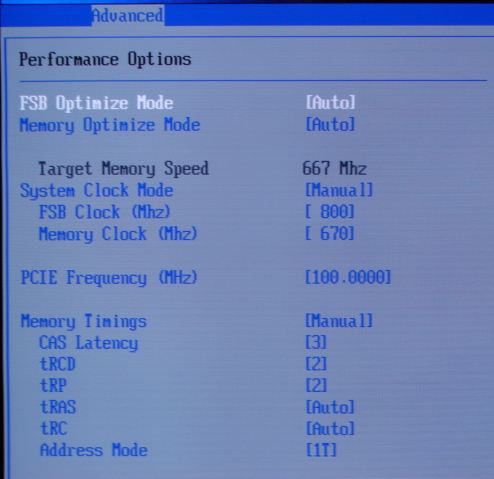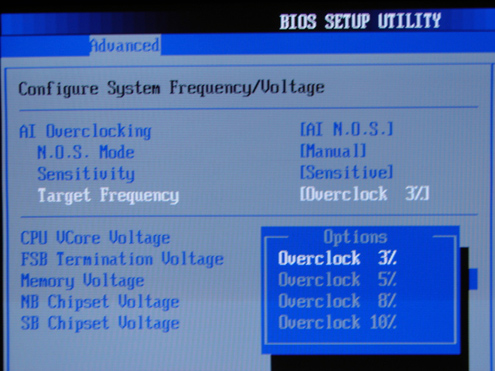Asus P5N32-SLI: Dual x16 - What Dreams Are Made On . . .
by Gary Key on October 27, 2005 12:05 AM EST- Posted in
- Motherboards
Basic Features: Asus P5N32-SLI Deluxe
The Asus P5N32-SLI Deluxe is a member of the ALife product family and, as such, is a fully-featured flagship board targeted towards the PC gamer. The board ships with an extensive accessory package along with several dynamic overclocking features such as AI NOSTM (Non-delay dynamic Overclocking System), AI Overclocking (intelligent CPU frequency tuner with preset profiles), ASUS PEG Link (automatic performance tuning for single/dual graphics cards), ASUS CPU Lock Free (BIOS setting to unlock select multiplier locked CPUs), and the ASUS Ai Booster Utility Precision Tweaker software that allows control over certain system settings within Windows. The board also features the exclusive 8-Phase power design, Copper Heat Pipe technology for cooling the chipsets, Stack Cool 2 design to dissipate heat to the opposite side of the motherboard, and an external SATA II port on the back I/O panel.
| Specification | Asus P5N32-SLI Deluxe |
| CPU Interface | LGA775-based Pentium 4, Pentium XE, Celeron D, and Pentium D processors. |
| Chipset | North bridge- NVIDIA nForce 4 SLI Intel Edition (Crush C19) South bridge- NVIDIA nForce 4 SLI Edition (Athlon CK804) |
| Pentium D Support (Dual-Core) | Full Support |
| Front Side Bus | 1066 / 800 / 533 MHz |
| Front Side Bus Speeds | 533-1600 MHz (in 1 MHz increments) |
| Memory Speeds | Auto- 400-1200 MHz (in 1 MHz increments) |
| System Clock Mode | Optimal, Linked, Expert |
| PCI Express | 100 MHz to 150 MHz in 1 MHz increments |
| Dynamic Overclocking | AI NOSTM (Non-delay Overclocking System) AI Overclocking (intelligent CPU frequency tuner) ASUS PEG Link (Automatically performance tuning for single/dual graphics cards) ASUS CPU Lock Free ASUS Ai Booster Utility Precision Tweaker for Windows |
| Core Voltage | Auto, 1.1V - 1.70V in 0.0125V increments |
| DRAM Voltage | Auto, 1.85 - 2.4V in 0.05V to 0.10V increments |
| Other Voltage | North Bridge - Auto, 1.4V, 1.5V, 1.6V South Bridge - Auto, 1.5V, 1.6V FSB - Auto, 1.215, 1.315, 1.415 |
| LDT (Hyper Transport) Ratios | 200, 400, 600, 800, 1000 |
| Memory Command Rate | Auto, 1T, 2T (current BIOS defaults to 2T) |
| Memory Slots | Four 240-pin DDR2 Slots Dual-Channel Unbuffered Memory to 16GB |
| Expansion Slots | (2) x16 PCIe Slots (1) x4 PCIe Slot (2) x1 PCIe Slots (2) PCI Slots version 2.2 |
| SLI | (2) x16 Fully Supported |
| Onboard SATA | (4)-Drive SATA 2 by nForce 4 |
| Onboard IDE | (2) ATA 133/100/66/33 ports, (4) drive support by nForce 4 |
| SATA/IDE RAID | NVIDIA® nForce4 SLI supports NVRAID - 2 x Ultra DMA 133/100/66/33 - 4 x Serial ATA 3 Gb/s - NVRAID: RAID0, 1, 0+1, 5, and JBOD Silicon Image® 3132 SATA controller supports - 1 x Internal Serial ATA 3 Gb/s hard disk - 1 x External Serial ATA hard disk (SATA On-the-Go) - RAID 0, 1 |
| Onboard USB 2.0/IEEE-1394 | (9) USB 2.0 ports supported by NVIDIA nForce 4 (2) 1394 FireWire ports supported by TI 1394a |
| Onboard LAN | Dual Gigabit Ethernet PCIe Gigabit LAN Support Marvell 88E1111 PHY, Marvell 88E8053 |
| Onboard Audio | Realtek ALC850 8-channel CODEC Universal Audio Jack Audio Sensing and Enumeration Technology Coaxial/Optical S/PDIF out ports on back I/O |
| Power Connectors | ATX 24-pin, 8-pin EATX 12V, 4-pin 12V EZ plug (required for SLI operation) |
| Internal I/O Connectors | 2 x USB connectors supports additional 6 USB 2.0 ports 2 x IEEE1394a connector 1 x COM connector 1 x GAME/MIDI connector CPU Fan / 2x Chassis Fan/ Power Fan / 2x chipset fan connectors Front panel audio connector Chassis Intrusion connector CD / AUX audio in |
| Other Features | Fanless Design AI NET2 network diagnosis CrashFree BIOS 2 Q-Fan2 MyLogo2 EZ Flash |
| BIOS | AMI 0047 |
The Asus P5N32-SLI Deluxe is a member of the ALife product family and, as such, is a fully-featured flagship board targeted towards the PC gamer. The board ships with an extensive accessory package along with several dynamic overclocking features such as AI NOSTM (Non-delay dynamic Overclocking System), AI Overclocking (intelligent CPU frequency tuner with preset profiles), ASUS PEG Link (automatic performance tuning for single/dual graphics cards), ASUS CPU Lock Free (BIOS setting to unlock select multiplier locked CPUs), and the ASUS Ai Booster Utility Precision Tweaker software that allows control over certain system settings within Windows. The board also features the exclusive 8-Phase power design, Copper Heat Pipe technology for cooling the chipsets, Stack Cool 2 design to dissipate heat to the opposite side of the motherboard, and an external SATA II port on the back I/O panel.












70 Comments
View All Comments
Beenthere - Thursday, October 27, 2005 - link
Why would ANYONE spend the coin to buy an Intel based SLI system when you can buy an AMD system for the same price that will out-perform the Intel system and be upgradable for years???The only reason I can see for anyone buying any Intel product at this time is if they are stuck with an Intel system already and they desire to upgrade to a faster chip if they can find one to fit whatever socket Mobo they have. Otherwise I see no logical reason whatsoever for even considering an obsolete, under-performing Intel product.
Shintai - Thursday, October 27, 2005 - link
You ask the wrong question. Why would anyone buy a SLI/CrossFire system at all.bob661 - Thursday, October 27, 2005 - link
He can ask any question he wants. There are no wrong questions.Because one can. :)Ricky Ling - Thursday, October 27, 2005 - link
I only afraid on the future upgradeability on this board because according to ASUS Support FAQ (as this news has not been revealed on the Internet), this board does not support future Pentium 4 that based on 65nm technology, namely Cedar Mill (Single core replacing Prescott) and Presler (Dual core replacing Smithfield)So how is testing done the Presler sample processor cause I thought Anand got holding of 1 Presler sample...Pls double check at the following :
http://support.asus.com/faq/faq_right_second_detai...">http://support.asus.com/faq/faq_right_s...P5N32-SL...
As Presler start hitting OEM already....we need more info on this issue???
Gary Key - Sunday, October 30, 2005 - link
The initial information I have from Asus this weekend is the board will support the 65nm CPU range with a bios update and the CPU steppings must be B1 or above.
Gary Key - Thursday, October 27, 2005 - link
Hello,I had already asked for public clarification about this issue from Asus after visiting the website last week. I believe the entire FAQ has not been properly updated as it still states the Pentium 820 will only work in single core mode which is no longer the case with this chipset revision. We have not had an issue testing the Presler or Cedar Mill CPUs with current board designs from different suppliers.
I will respond once I have further information.
Thank you.
Chuckles - Thursday, October 27, 2005 - link
How's the clearance on the right-most PCIe x1 slot? It looks like a card put in there would be perilously close to the northbridge heatsink.Gary Key - Thursday, October 27, 2005 - link
Hi,The D-Link DGE-560T PCIe network adaptor card fit fine and it is the longest card I tried in the x1 slot. I would agree if a card had several logic chips placed in the right area on the back of the board then clearance could be an issue with the heatsink. However, the few peripheral PCIe cards that I have fit fine.
erwos - Thursday, October 27, 2005 - link
I wouldn't have minded seeing the difference between bridged SLI and bridgeless SLI on both SLI Dual x16 and SLI Dual x8 motherboards.My gut feeling is that nVidia is going to be phasing out the bridge in the near future, if they can get the same performance without it using the PCIe bus.
-Erwos
DigitalFreak - Thursday, October 27, 2005 - link
"ASUS CPU Lock Free (BIOS setting to unlock multiplier locked CPUs)"Does this mean that all multipliers (up and down) are available again?